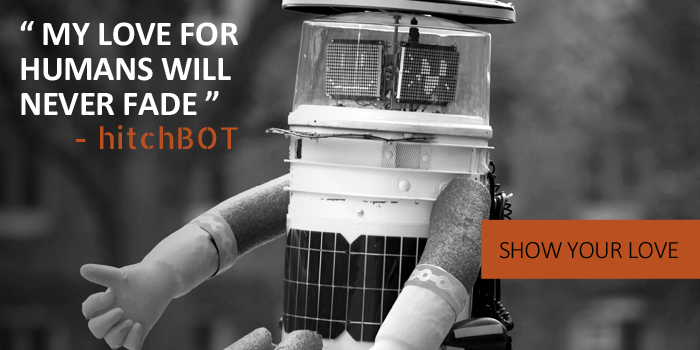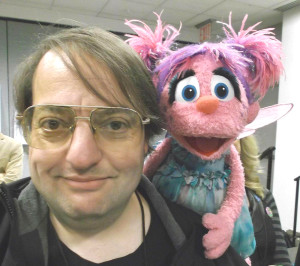Depending on who picked up “HitchBOT” and the route that person took, the robot might have passed through Benicia or other parts of Solano County on its coast-to-coast travels.
That won’t happen now.
HitchBOT met a violent end in Philadelphia at the hands of a vandal who destroyed the canister-shaped assembly with rubber glove arms, rubber boot feet and an electric-light smile.
The violent episode, caught by a nearby security camera, brought to an end the international social experiment that started July 27, 2014, in Halifax, Nova Scotia, Canada.
Christopher Smigliano first learned about HitchBOT through the newspaper for which he supplies local issue-based editorial cartoons, the Salem (Mass.) News. The robot started its U.S. adventure July 17 alongside a highway near Salem with a sign, “San Francisco or Bust,” waiting until a stranger picked it up.
“I had no knowledge it even existed before then,” Smigliano said. “The idea struck me as both funny and strange at the same time. I mean, a hitchhiking robot?”
The 3-foot-tall robot was made in Port Credit, Ontario, by Dr. David Smith of McMaster University and Dr. Frauke Zeller of Ryerson University. The two communication researchers told Dustin Luca, a Salem News reporter, that one purpose of the experiment was to answer two questions: whether people can trust robots and whether robots can count on humans.
The solar-powered and rechargeable HitchBOT could participate in basic conversations and had a geo-positioning device and a 3G connection so its travels could be tracked. It periodically took photographs.
The one thing it couldn’t do: walk. HitchBOT depended entirely on kindly strangers to move from place to place.
Many took to the little robot, following its adventures online and anxiously awaiting news that it had visited some of the places it “requested” to go.
In Canada, when its communication system blanked for two days, concerned HitchBOT fans asked whether they should mount a search. Thousands did just that.
Throughout its European journey, the robot was taken to multiple festivals on its list of things to do. In Germany, it stopped by such landmark sites as the Neuschwanstein Castle, the Brandenburg Gate and the Cologne Cathedral. It attended a wedding and participated in a parade.
In the U.S., HitchBOT’s requested stops were New York’s Times Square, Myrtle Beach in South Carolina, South Dakota’s Mount Rushmore, Pixar’s “Up” house in Utah, such natural landmarks as the Grand Canyon and Yellowstone National Park, and such tourist attractions as Walt Disney World in Florida and California’s famous “Hollywood” sign.
Smigliano, in his cartoon marking the robot’s arrival and the start of its journey, parallels with another situation the reality of a robot seeking a cross-country lift.“The idea of a hitchhiking robot brought to my mind the controversies of having certain jobs outsourced or taken over by machines,” he said.
“I had nothing against the main aspect of ‘HitchBOT,’ but yet something about it seemed too tempting to avoid some sort of parody. I mean, we may soon have self-driving cars.”
Smigliano drew a cartoon published by the News that shows a man with thumb extended, fussing that machines have been taking people’s jobs. Eying the pint-sized HitchBOT’s glove in the same gesture, the hitchhiker says, “ — But this is a bit much!”
The artist said he could have mined HitchBOT for other humorous cartoons. “A concept like that just lends itself to creative opportunities. … I contemplated having HitchBOT stick out a sexy lady’s leg instead of using its thumb — but I didn’t think my editor would let me get away with that one.”
Smigliano, who said he was “fueled by a steady diet of comic books, classic animation, Saturday morning cartoon shows and, of course, Muppets,” has been drawing since he was in kindergarten.
He’s been inspired by the Muppets’ Jim Henson, animation director Chuck Jones, French artist Albert Uderzo — who with Rene Goscinny created the “Asterix” comic book and other titles — and “Pogo” comic strip artist Walt Kelly. “No one could handle an inkbrush like Kelly!” Other influences are “a whole mishmash of amazing talents from comics to animation to puppetry.”
Smigliano designed posters for school projects and was published in his eighth grade Horace Mann Elementary School yearbook.
In high school, he contributed to the Salem News “kids page” section. He landed his first major job while attending Montserrat College of Art in Beverly, Mass., drawing a full-page strip for Nautica, a sea-based magazine.
When that publication folded, Smigliano launched his freelance career, contributing for more than 20 years to a former American standard, the Comics Buyer’s Guide. He also has found audiences in such various genre publications as “Myth Information,” based on the Robert Asprin “Myth Adventures” novel series, and Danny Horn’s “Muppetzine” that has become the “Toughpigs” website.
His association with the Salem News began in 2001, when its editor, Nelson Benton, liked Smigliano’s sample mailer and asked for a few tryout cartoons based on local issues.
Benton liked what he saw, and Smigliano has been contributing to the newspaper ever since.
“I’m basically freelance on the paper, and they tell me to strictly stick to local themes, though occasionally I do get a national one in,” Smigliano said.
HitchBOT’s arrival in Salem was both a local matter and international news.
The more Smigliano learned about the little robot that came to his town, the more impressed he was with the social experiment.
“I was amazed it made it through other countries,” he said. “I got a little cynical when I read they were going to try it here, though, and I’m afraid I was right.”
Just as he learned about the existence of HitchBOT through his local paper, he read about its demise in the same publication.
In the paper’s Aug. 4 edition, News reporter Will Broaddus wrote that Salem residents who had met the robot at a party in Peabody Essex Museum on July 16 before it started its American journey were in mourning.
Meanwhile the researchers behind the HitchBOT experiment have said they won’t press charges against the man shown in the security camera footage kicking the popular little robot to pieces.
The scientists were sent a photograph showing HitchBOT’s “pool-noodle arms ripped from its torso, its plastic cake saver skull and robot brain nowhere in sight,” Broaddus wrote.
As it said on HitchBOT’s website, “Sometimes bad things happen to good robots.” HitchBOT’s trip to the United States lasted just 300 miles.
“I’m sorry to say I wasn’t surprised. I’m not sure what to say,” Smigliano said, expressing regret at how the destructive act in Philadelphia affects the country’s reputation.
“I know there are idiots everywhere, but when you read things like in Japan you can walk the streets late at night, and vending machines that dispense alcohol are available right on the street yet not broken into, yet people here feel like they have to break something just to show how badass they are or disagree with something, it makes us look like cavemen,” he said.He said he is heartened somewhat by news that the HitchBOT team may assemble another robot to pick up where HitchBOT left off. So he has produced another cartoon he’s submitted to the Salem News.
“The gist of the backup cartoon is if they rebuild it, it should be modified in a way to make sure that no one would dare touch it,” Smigliano said. “I would like to see them try again, though I think they should up its security a bit.”
But he also sees some good coming from HitchBOT’s destruction.
“In a way, the publicity from its wrecking might help it this time around,” he said. “I think it may have a better chance, now that the public is more aware.”









Leave a Reply